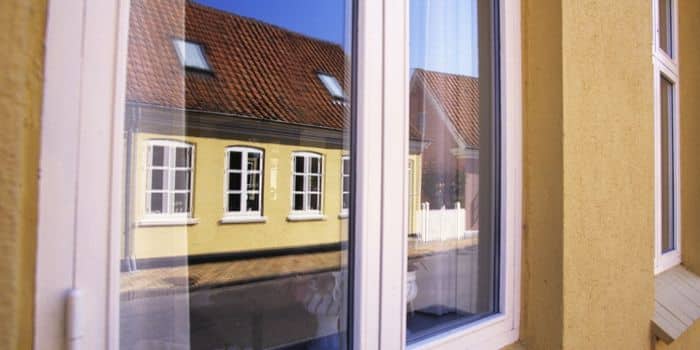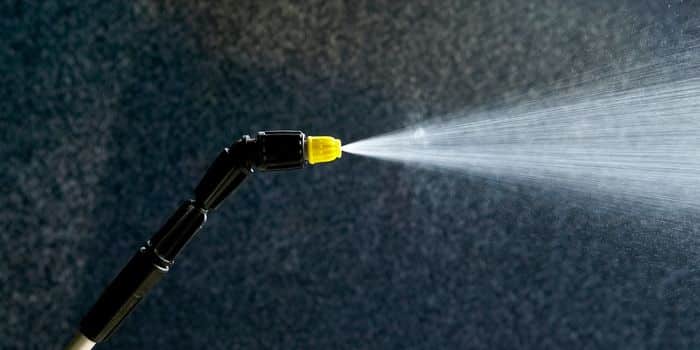So, you've got some render that's looking a bit worse for wear. Don't worry! We can help. In this article we'll explain exactly what render cleaning involves and how it works, as going through the best practices to follow.
We have many years of experience in this area, so you’ve come to the right place.
Simply put, render cleaning is taking any rendered surface and getting it looking brand-spanking new again. It’s the process of removing loose/cracked render and feathering the edges, as well as giving it an alkaline clean (e.g. mould removal) and finally rinsing.
Following through with all stages the repair process is crucial, and the work must be carried out with care, as it can lead to further damage if not done properly. The render should be removed down to good brickwork or cement render (i.e. the layer below), which will provide a sound base for plastering over and disguising any cracks that may appear in this area.
If the render is in good condition and only needs minor repairs, this should be done before the cleaning process.

The cost of render cleaning will depend on the size of the area to be cleaned. It can also vary depending on whether or not you have any existing render repair work that needs doing in addition to the cleaning. We take into account the type of render and its condition, as well as how much access will be required to clean it properly.
We can provide you with an accurate quote for render cleaning when we visit the property. This will include any work that may need doing in addition to the cleaning, such as repairing broken pipes or regrouting areas where damage has occurred.

The first action to be undertaken is always to remove loose or cracked render, use a long-handled wire brush to sweep away dust and debris from the surface. This will help to improve adhesion when applying the new render. If there is any mouldy render present, this needs to be removed with bleach or similar products. You should always wear protective clothing and gloves when cleaning mouldy surfaces.
If you are using a lime-based render, you can use a soft wire brush to remove loose dust and debris. For best results, apply a thin layer of water to the surface before sweeping.
Loose and cracked render is a problem for any home, but it's especially dangerous in a bathroom. If left untreated, mould will grow inside the wall cavity, which can cause major damage to your walls. To prevent this from happening:
Next, you will need to apply any new render required, which will depend on whether there was any significant damage to the existing render.
Once your render has been applied, you will want to remove any loose material. This is done with a scraper or a brush. A scraper is used where the render was cut in straight lines, whereas a brush can be used for more intricate work.
A roller is then used to apply render sealer, which helps prevent moisture damage and makes the surface resistant to dirt and stains.
For areas where water repellency is desired (such as around swimming pools or patios), you can use a paintbrush to apply water repellent coating.
Once the render is finished, you will want to clean it up and make sure there are no drips or runs. You can use a trowel for this purpose.
If you want to create an artistic finish, you can use a brush or roller to apply render mastic. This is usually done with a trowel for small areas and a float for larger ones. When using the float, it is important that you do not drag it across the surface; otherwise, streaks will appear in your finished render job.
For the most thorough and effective way to remove mould from your walls, you will want to use an alkaline cleaning solution. This is a process that involves applying a chemical solution directly onto the surface of the wall, allowing it to sit for a period of time (usually about 15 minutes), and then scrubbing it off with soft bristled brushes. While this process may seem intimidating at first glance, it’s actually quite easy if you follow these steps:
Use a long-handled brush or putty knife to scrub away any remaining residue.
There are a few ways you can rinse.
A pressure washer is the best way to clean off excess dirt; this can be done by hand, or by attaching it to a large water tank for more thorough cleaning.

Water repellent coatings are designed to protect surfaces from water damage. They can be applied to a variety of surfaces in order to help protect them from damage caused by exposure to water, including:
Water-repellent coatings are environmentally friendly and easy to apply.
These coatings can be applied to a variety of surfaces, including: House roofs Patio furniture and chairs Driveways (especially those that are newly paved) Water-repellent coatings are environmentally friendly and easy to apply. They require minimal maintenance and will last for years.
Apply the render sealer when the render has just been applied and before it dries out or else you risk damaging both your brush and the surface of your wall.
Render sealer is available in a variety of different colours and can be applied using a brush or roller. The recommended time for application is between two and three hours, but this will depend on the weather conditions and what type of render you are using.
Once you have applied the render sealer, leave it to dry for at least a day before you apply any other coatings or materials.
A really thorough job,excellent work.This was a big job with zero complaints.Thank you MidRender UK.

There are several ways to remove dirt from render, but the method you use will depend on your preference and what cleaning solution you have available. The most important thing is to make sure that the cleaning solution you use is non-toxic and safe for your home.
Many people like to use a soft brush or cloth to clean the render, while others prefer using a paint scraper or sponge instead. If you’re thinking about using a brush or cloth, we would recommend using an old one so as not to damage any existing brushes/cloths you may have lying around at home, just in case!
If you’re thinking of using a paint scraper or sponge, we would recommend doing so with care as these are more likely to scratch the render than a brush or cloth.
Many people believe that render is maintenance free, but this is not true. If left un-maintained, render will eventually start to deteriorate and cause problems with your building.
Render is porous and can absorb water. This can lead to mould growth and damage the structure of your building if it’s left untreated for too long.
The best way to stop this from happening is by regular maintenance services such as pressure washing of the exterior walls at least once every 12 months or so depending on weather conditions in your area and if you have an exterior render cleaning service. This will help to keep your building looking great and prevent any damage from occurring. When choosing a pressure washing company, ensure they have experience in cleaning exterior walls with render.
How often render should be cleaned depends on the usage of the building. If it is used daily, then it must be cleaned more regularly than if it is not used at all. The other factor to consider is whether water drips or runs down the render and causes staining. If this happens to your property, then you will need to clean off any moss and lichen growth more often.
If you are unsure of how often to clean the render, then it is best to consult an expert who can advise on what is best for your property.
Render cleaning is an essential element of making your home look its best. Render, otherwise known as cement-based render or stucco, is a popular choice for exterior walls in the UK. It's easy to work with, durable when it dries and looks great too. Unfortunately though, over time render can become dirty and stained due to airborne pollutants such as soot from chimneys and smoke from cars on busy roads nearby. This can make your home look grubby which can be off putting especially if you want to sell it sometime soon.
To clean your render properly without using harmful chemicals we recommend using a natural neutraliser, which is available from any DIY store. This product will safely remove any dirt that has accumulated on top of the surface layer of your render but it doesn't contain any dangerous chemicals whatsoever meaning that there's no risk whatsoever from using this solution anywhere near children or pets
Render is a material that will last for decades, so it’s worth taking the time to maintain. The condition of your render can make all the difference in how long it lasts. If you maintain your render throughout its life and keep it clean, then it should last for up to 20 years.
If you don’t clean or maintain your render, then it won’t last as long as if you did. It is important to keep an eye on small cracks in rendering before they become larger ones that need repair work done on them. This can be done by getting someone who knows what they are doing with rendering to come round and give advice about how best to look after your home so that nothing goes wrong!
If you have any questions about the maintenance of your render, then call us. We can advise you on how best to look after your home and keep it looking good for years to come!
We think that after reading this, you have a much better idea of what render cleaning is and how to get it done. We hope that you’ve got all the information you need to make an informed decision about whether it’s something worth doing at all, but if not then please feel free to give us a call or drop us an email so we can help!
The best way to clean render is to use a gentle brush, and warm water. Gently scrub the surface of your wall, then rinse the brush under warm water. The key thing is not to use anything that will damage your wall - so no harsh chemicals!
Yes! You can pressure wash rendering using a low pressure washer and it will do the job well. Increase the pressure and you may damage your rendering.